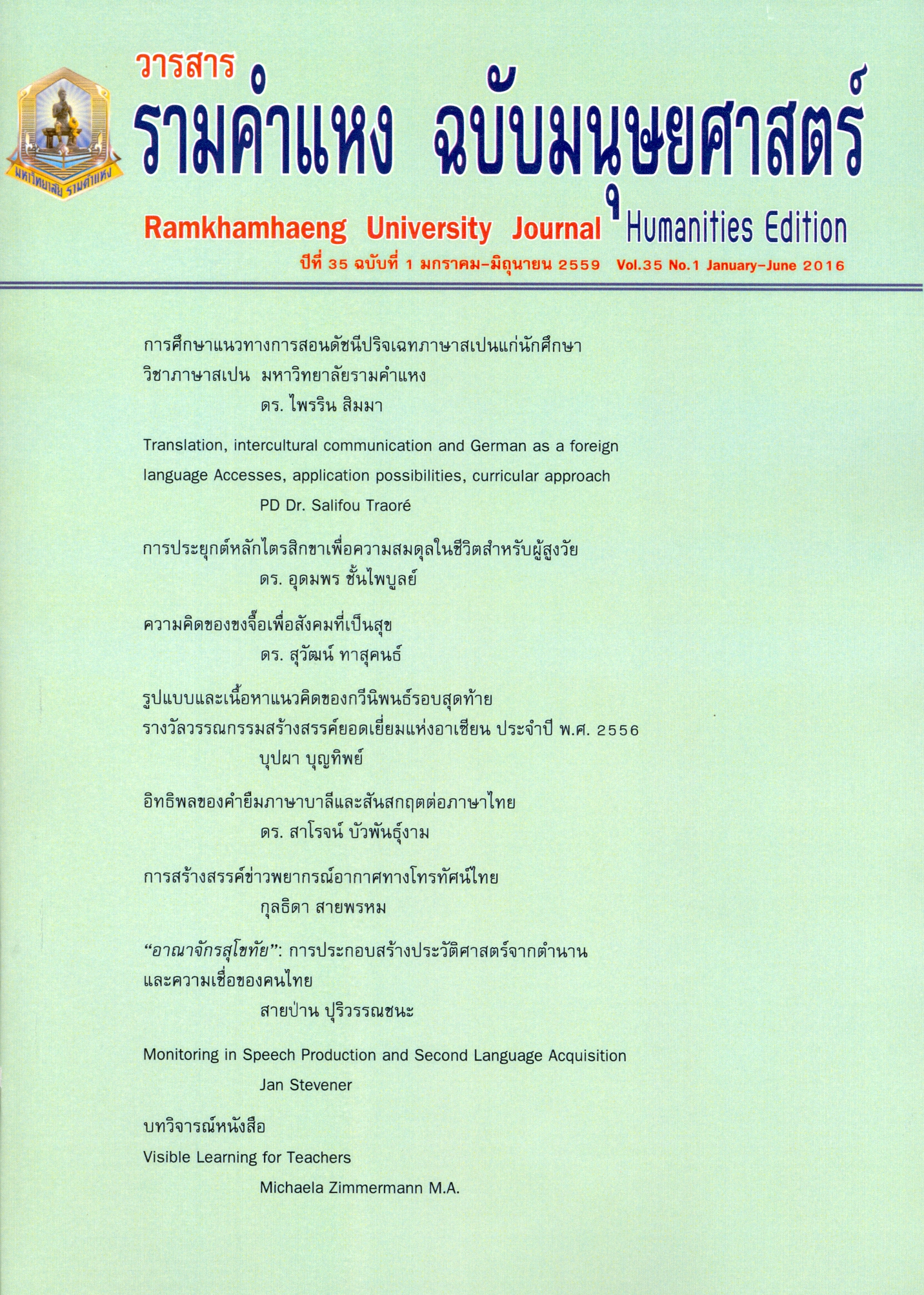Translation, intercultural communication and German as a foreign language Accesses, application possibilities, curricular approach ความสัมพันธ์ระหว่างการแปล การสื่อสารข้ามวัฒนธรรม และการเรียนการสอนภาษาเยอรมันในฐานะภาษาต่างประเทศ: การเข้าถึง โอกาสนำไปใช้
Main Article Content
บทคัดย่อ
Abstract
The debate on translation in foreign language teaching is grounded in a long tradition going back to the grammar translation method. This teaching method aimed essentially to develop translation skills. To achieve this, the foreign language learner had to translate sentences and texts into and out of the target language and be hence able to show that he/she had understood the lexical structures and grammar rules of the foreign language and could put them to practical use, independent of context. The first language was the reference system in the acquisition of the foreign language. The opposition to the grammar translation method led to the next teaching methods, such as the direct method and the audiolingual method, to the abandoning of the first language and thus also translation in the acquisition of the foreign language. However, since the 1970s there has been an increasing debate on the purpose of translation in foreign language teaching and learning. Concerning German as a foreign language as a more recent academic discipline there has been little debate on the subject.
Therefore this research work attempts to discuss the roles that translation plays in the process of teaching and learning German as a foreign language in the context of globalisation and interculturality. On the basis of this discussion, the present work is looking at possibilities for integrating the results of the analysis in the classroom and the curriculum of teaching and learning German as a foreign language in a homogenous learning context.
บทคัดย่อ
การศึกษาประเด็นการแปลในบริบทการสอนภาษาต่างประเทศเป็นขนบที่สืบทอดกันมาอย่างยาวนาน โดยมีจุดเริ่มต้นจากวิธีการสอนแบบเน้นไวยากรณ์และการแปล วิธีการนี้ตั้งเป้าหมายที่จะพัฒนาทักษะด้านการแปลไว้ว่า ในการแปลทั้งการแปลให้เป็นภาษาต่างประเทศและการแปลมาจากภาษาต่างประเทศนั้น ผู้เรียนจะต้องสามารถแสดงให้เห็นได้ว่า ผู้เรียนเข้าใจและสามารถนำกฎเกณฑ์ไวยากรณ์และโครงสร้างทางคำศัพท์ของภาษาต่างประเทศนั้น ๆ ไปใช้ได้ โดยไม่ต้องอาศัยบริบท กระแสวิพากษ์วิจารณ์วิธีการสอนแบบเน้นไวยากรณ์และ การแปล ได้นำไปสู่การหันหลังให้กับภาษาแม่และการแปลไปโดยปริยายในการเรียนการสอนภาษาต่างประเทศในเวลาต่อมา ดังจะเห็นได้จากวิธีการสอนแบบใช้ภาษาต่างประเทศสอนโดยตรงและวิธีสอนแบบฟังและพูด/ฟังและดูภาพ เป็นต้น อย่างไรก็ตาม ตั้งแต่ช่วง ค.ศ. 1970 เป็นต้นมา มีการตั้งประเด็นคำถามเกี่ยวกับความหมายและบทบาทของการแปลในบริบทของการเรียน การสอนภาษาต่างประเทศมากขึ้นเป็นลำดับ โดยเป็นคำถามที่ไม่ได้เกี่ยวกับเรื่องการแปลในฐานะเป็นเครื่องมือช่วยในการสอนภาษาและไม่เกี่ยวกับแบบฝึกฝนการแปลเพื่อใช้ในการตรวจสอบทักษะทางภาษาทั่ว ๆ ไปแต่อย่างใด หากเป็นประเด็นเกี่ยวกับการพิจารณาการแปลในฐานะเป็นเครื่องมือสื่อสาร (ข้ามวัฒนธรรม) ทั้งในด้านส่วนตัวและด้านอาชีพในโลกยุคโลกาภิวัตน์ และวัฒนธรรมข้ามชาติ เพื่อเตรียมความพร้อมให้ผู้เรียนสามารถประยุกต์ใช้ภาษาต่างประเทศได้ ในสถานการณ์จริง ด้วยเหตุนี้ จึงจำเป็นที่จะต้องให้คำจำกัดความการแปลในการเรียนการสอนภาษาต่างประเทศขึ้นมาใหม่ ซึ่งตลอดเวลาที่ผ่านมาแทบจะไม่มีการพูดถึงประเด็นนี้เลย ในสาขาวิชาภาษาเยอรมันในฐานะภาษาต่างประเทศ ดังนั้น งานวิจัยชิ้นนี้จึงเป็นความพยายามที่จะอุดช่องโหว่ทางวิชาการและวิจัยที่เกิดขึ้น ทั้งนี้จะมุ่งศึกษาผู้เรียนภาษาเยอรมันเป็นภาษาต่างประเทศในระดับอุดมศึกษาในสภาพการเรียนรู้ที่ทุกคนพูดภาษาแม่เดียวกันเป็นสำคัญ
Article Details

อนุญาตภายใต้เงื่อนไข Creative Commons Attribution-NonCommercial-NoDerivatives 4.0 International License.
ประกาศลิขสิทธิ์จะปรากฏในเกี่ยวกับวารสาร ควรอธิบายสำหรับผู้อ่านและผู้เขียนว่าเจ้าของลิขสิทธิ์เป็นผู้เขียนวารสารหรือบุคคลที่สาม ควรรวมถึงข้อตกลงการอนุญาตเพิ่มเติม (เช่นใบอนุญาตครีเอทีฟคอมมอนส์) ที่ให้สิทธิ์แก่ผู้อ่าน (ดูตัวอย่าง) และควรให้วิธีการรักษาความปลอดภัยหากจำเป็นสำหรับการใช้เนื้อหาของวารสาร


